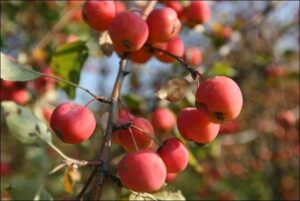By Eric Garris

The apples we know today: brilliant reds, greens, yellows with a hint of blush, were not always so aesthetically pleasing, nor was their taste delightful, sweet, and crisp. The first apples before domestication were actually small hard fruits resembling our common crabapple. Tasteless, unpalatable, and enjoyed only by wildlife, it was from the wild apple (Malus sieversii) that the journey to apple splendor began. Native to Kazakhstan and surrounding regions, the wild apple grows on cool mountainous slopes in natural groves. In 2010, it was determined that Malus sieversii was the primary ancestor of the domesticated apple. Through selective breeding for desirable traits, over 200 varieties of apples are grown by 7,500 producers to net over $2.7 billion of apples in the U.S . alone.
Through competition for grazing land and new development, much of the natural population is being destroyed. In these populations lies the genetic key to cold and drought tolerance and disease resistance that may be further bred into our domesticated apples. Researchers are currently involved in gathering seed and cuttings from remote regions of Kazakhstan to preserve the wide genetic diversity within the species.
Want more Vanishing Acts? Click here to view the archive.
Vanishing Acts: Trees Under Threat was developed and produced by The Morton Arboretum in association with the Global Trees Campaign, a partnership between Fauna and Flora International and Botanic Gardens Conservation International.
Funding for this exhibit comes from The Morton Arboretum and the U.S. Institute for Museum and Library Services, Museums for America Grant Program.
Support locally comes from LG&E and KU. Additional support provided by Shepherdsville/Bullitt County Tourism.

